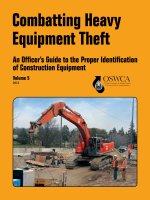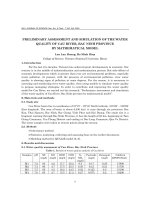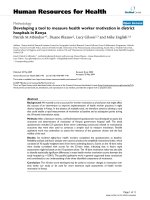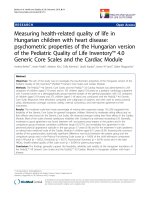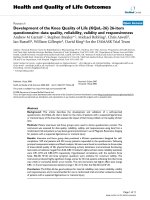Developing the dimensions to measure the service quality of construction project management
Bạn đang xem bản rút gọn của tài liệu. Xem và tải ngay bản đầy đủ của tài liệu tại đây (8.6 MB, 11 trang )
I
."
~~-
. t~\ ;;_._,~ _.•
-
" /
_-
VIETNAMESE ACCOUNTING
&
INTERNATIONAL ACCOUNTING STANDARDS
September 2010
Number 193
ISSN1859-1116
First published in 1994
16th year, 2010
Published monthly on the 1
st
WWW.tcptkt.ueh.edu.vn
TOPIC
VIETNAMESE ACCOUNTING AND
INTERNATIONAL ACCOUNTING STANDARDS
2.
Assoc. Prof. Dr. Truonq Ba Thanh & Huynh Th] Hong Harth, MBA,
Back-Flush Accounting in Just-in-time Business
7.
Dr. Pharn EJucHieu, Fair Value Accounting Versus Financial Crisis:
Debates and Reality of Vietnam
13.
MEcon. Bui Quang Hung, The Effects of Software Fit and User
Adaptation on the Success of Accounting Packaged Software
Implementation
21.
Dr. Nguyen Cong PhLldng, Connections Between Taxation and
Accounting in Vietnam
27.
Dr. Nguyen Thuy Ouynh Loan & Phan Minh Nhut, Factors Affecting
Consumer Behavior in the Soft Drink Market in HCMC
34.
Dr. Ha Nam Khanh Giao & Nguyen Doan Trang, MBA, Developing the
Dimensions to Measure the Service Quality of Construction Project
Management
. .'- . . to.
'0
'ECONOMY& LIFE . £;o~:~:
43.
For Foreign Tourists
44.
News in Brief
45.
Time & Events
48.
Markets & Prices
Letters and articles, please send to
Tran Le Phuc Thinh
Economic Development Review
59C Nguy.§n E>inh Chi~u, District 3,
Ho
Chi Minh City
Tel: 38295635 - 22413173 - Fax: 84.8.38295635
Email:
VND 18,000
-'
RESEARCHES
&
DISCUSSIONS
DEVELOPING THE DIMENSIONS TO MEASURE
THE SERVICE QUALITY OF CONSTRUCTION PROJECT MANAGEMENT
by Dr. HA NAM KHANH GIAO·
&
NGUYEN £)OAN TRANG, MBA
services are in the first two categories. As a kind
of credence-based services, professional services
are also intangible, inseparable, variable and per-
ishable. Unlike other service organizations, pro-
fessional service providers have to deal with high
level of uncertainty, limited service differentiabil-
ity, and difficulties in quality control; have to face
some distinctive problems that have not been
faced by other types of service organizations such
as client uncertainty, limited service differentia-
bility, quality control difficulties, and several ob-
stacles to mounting a successful marketing effort
(Kotler et al, 2002). Named as goods of credence,
the professional services attract the buyer by
great faith in consultants who sell the service be-
cause services are usually lack many attributes
that a buyer can confidently and competently eval-
uate before, or even after, making a purchase de-
cision (Bloom, 1984).
b. Project management service in the con-
struction industry:
Although the construction industry produces
tangible items and has been categorized as a pro-
duction instead of service activity, the industry
still has some following features that have been
characterized for service sector: they cannot be
stored (perishability); it is impossible to sell the
expertise inside the landmark once it is commit-
ted or used; the processes of service production
and service consumption are inseparable (insepa-
rability); the fact that construction products can-
not be standardized makes the nature of
heterogeneity of the industry; the intangible in
the construction process can be shown in the pre-
liminary design (intangibility).
There are various definitions of project man-
agement provided by Cleland (1990), Kerzner
(1992), Turner (1994), and Pinto
&
Kharbanda
(1995). Emphasized on the client satisfaction,
Walker (2002) conceptualized project management
as the planning, control and coordination of a proj-
ect from conception to completion on behalf of a
Abstract
In construction industry today, the consultancy
companies need to improve their service quality -
an important part of consultancy service in order
to enhance the customer's loyalty, boosting the
business for future projects and word of mouth rep-
utation. The question arises as to whether or not
the dimensions used for measuring the quality of
the generic services can be applied to the profes-
sional services such as the construction project
management service. If yes, how to do so? This re-
search is based on the literature review, especially
Parasuraman et al. (1985, 1988), Hoxley (2004),
Murugavarothayan et al. (2000) and Ong (2007);
and the qualitative method to suggest possible set
of dimensions to measure the service quality of the
construction project management.
1. Basic concepts
a. The nature
of
service:
A service has been defined by many scholars:
Kotler et al. (2002), Gronroos (1979, 2001),
Gummesson (1993), and Lovelock (1991). In a
brief way, Kotler
&
Amstrong (2001, p. 291)
shaped "services are a form of a product that con-
sist of activities, benefits, or satisfactions offered
for sale that are essentially intangible and do not
result in the ownership of anything." Services
have the following four key distinguishing attrib-
utes: Intangibility, Inseparability, Heterogeneity,
and Perishability (Kotler
&
Bloom, 2002).
Kotler
&
Keller (2006) classify products/ser-
vices into three categories in the continuum based
on the difficulty of evaluation of products/services
quality: (1) Credence-based qualities: the buyers
find hard to evaluate even after purchase such as
legal service, medical service, and education serv-
ice; (2) Experience-based qualities: the buyers can
evaluate after purchase such as hairdressing,
travel, accommodation, and hotel service; and (3)
Search-based qualities: the buyers can evaluate be-
fore purchase such as clothing, in which most of
- • International University - Vietnam Nation University HCMC
Economic Development Review - September 2010
RESEARCHES
&
DISCUSSIONS
client. It is concerned with the identification of
the client's obje~itivesin terms of utility, function,
quality, time and cost, and the establishment of
relationships between resources. The integration,
monitoring and control of the contributors to the
projects and their output, the evaluation and se-
lection of alternatives in pursuit of the client's sat-
isfaction with the project outcome are fundamental
aspects of construction project management. In
summary, project management brings together a
set of skills, a suite of tools, and a series of
processes.
c.
Service quality:
There are a number of different definitions to
service quality from scholars: Peters
&
Austin
(1985), Zeithaml
&
Bitner (1996), Harvey (1995),
Boomsma (1993), Lewis (1993), and Juran (1988),
among others. One that is commonly used claims
service quality as the extent to which a service
meets customers' needs or expectations i.e. what-
ever the customers say it is and whatever the cus-
tomer perceives it to be (Buzzel
&
Gale, 1987;
Lewis
&
Mitchell, 1990; Dotchin
&
Oakland, 1994;
Asubonteng et al., 1996; and Wisniewski
&
Don-
nelly, 1996).
According to Berry etal. (1988), service quality
can be considered the most powerful competitive
weapon available to service providers. Other re-
search has also established that service business
success is associated with the ability to deliver su-
perior service quality (Gale, 1990; Rudie
&
Wans-
ley, 1984; and Zeithaml, 2000). Therefore, an
understanding of the nature of service quality and
how it is achieved in the organizations has become
a priority for research (Zeithaml et al, 1988).
2. Dimensions of service quality of the construc-
tion proitlCi management
Several studies have been conducted to identify
service quality dimensions that significantly con-
tribute to quality assessments in the service envi-
ronment. In this paper, we will pay attention to
the following scholars.
a. The SERVQUAL by Parasuraman, Zei-
thaml and Berry (1985):
The Gaps model of service quality was formed
by Parasuraman et al. (1985) based on ten deter-
minants: Reliability; Responsiveness; Credibility;
Competence, Access, Courtesy, Security, Commu-
nication, Tangibles, UnderstandinglKnowing the
customer. Then, in 1988, they performed scale pu-
rification on their original model of ten determi-
nants and reduced their model to only five
dimensions, which include Tangibles, Reliability,
Responsiveness, Assurance and Empathy.
Based on the said five dimensions, SERVQUAL
instrument consists of a 22-item instrument for
assessing service quality based on customer's per-
ceptions, which is the differences between the cus-
tomer's perceived quality and his/her expectations.
The perceived quality is assessed based on service
quality dimensions that correspond to the criteria
It has become apparent that SERVQUAL is the
most popular standardized questionnaire used to
measure service quality to date, with several ap-
plications.
b. Understanding 12 essential elements for
the effective project management (Ong, 2007)
via Parasuraman's 10 original quality dimen-
sions:
Recently, Ong (2007) summarizes 12 essentials
elements for the effective project management
needed in formulating and facilitating the effec-
tive project management to achieve project excel-
lence and success.
It is impressive that 12 essentials elements are
closely related to some of original service quality
dimensions defined by Parasuraman et al. (1985)
as below description:
However, it is evident that the said elements
just totally explain some skills needed for ensur-
ing the quality of service delivery process. Thing
to be pondered is about the final outcome because
most of investors pay high attention to the value
of what they received against the amount of
money they spent on a long term investment
building project.
c.
Service quality model by Muru-
gavarothayan et al. (2000):
Murugavarothayan et al. (2000) conclude the
model of criteria for customer evaluation of the
construction professional service offered, in which
the determinants of consultant service quality will
be listed and ranked in order of priority: Reliabil-
ity, Assurance, Empathy, Time of Project comple-
tion, Responsiveness, Function of completed
project, Quality of completed project, Final cost,
Tangibles.
In general, despite being basically built on the
Economic Development Review -
September 2010
RESEARCHES
&
DISCUSSIONS
Table 1: Correspondence between effective elements of project management to original ten dimensions of
SERVaUAL
III
C
Cl
III
0
Essential elements neces-
Q)
Q)
C
III
>-
C
U
>-
>-
;:
Q)
:!::
C
:!::
>-
(II
"t:I
sary in formulating and fa-
Q)
III
-
III
Q)
.!:!
t:
J:I
.~
Q)
.;:
III
J:I
-
-
J:I
Q)
(II
cilitating
effective
project
III
Q)
:::I
C
-
Cl
.s
C
Q.
:::I
"t:I
U
U
:::I
III
management for construe-
t:
Qj
0
E
0
Q)
Q)
c
E
•
(II
(J)
<l:
Q)
tion projects.
~
a:
Q.
0
U
o
E
."t:I
III
U
0
e
Q)
U
:J
a:
1.Understanding of the
ob-
jectives and priorities
x
2.Understanding of the proj-
ect nature and characteris-
x
tics
3. Management of the project
x
risks
4. Selection of a suitable
project team
x x x x
S.Using ofa suitable building
x
x
x
procurement system
6.Use of a suitable contrac-
tual arrangement
x x
x
7. Effectiveorganization
x
x
x
structure
8. Having proper and appro-
x
x
x
x
priate planning
9. Effective monitoring and
x
x x x
control systems
1a.Good information record-
ing and retrieval systems
x x
11. Abilityto adapt and man-
x
age change
12. Good commercial/busi-
ness and human relations
x x
SERVQUAL model, the framework of service qual-
ity evaluation proposed by Murugavarothayan et
al. (2000) is similar to those of Gronroos's service
quality model (1982, 1990) on the aspect that it
tries to emphasize on what client is left when
service production process has ended.
d. Michael Hoxley's SURVEYQUAL (2000,
2004):
Hoxley (2000) has discussed the development
of a 26-item scale for assessing service quality in
a
UK
construction professional service context.
The data collection involves the assessment of 244
professionals by their clients. The findings of the
research are that construction professional service
quality can be described as a four-dimensional con-
struct (the writer has called the factors "what",
"how", "when" and "who"). In 2004, an additional
scale item which demonstrates good awareness of
health and safety issues was added. Thus, it is a
27-item scale for assessing service quality in the
construction professional service. The contents of
criteria are listed on table 2, in which a
SERVQUAL framework is referred and basically
used to construct the SURVEYQUAL measure
scale for the construction professional services.
e.
Developing the dimensions to measure
the service quality in construction project
management:
Economic Development Review - September
2010
RESEARCHES
&
DISCUSSIONS
;
•.
Table 2: Hoxley (2004) service quality scale
HOXLEY'S
FACTORS
SERVQUAL (PZB, 1991) SURVEYQUAL (HOXLEY, 2004)
Generic Service Quality Measure Assessment of Professional consultant
~
~
Z
0
<C
w
J:
0
J:
J:
~
J:
~
~
Modern looking equipment
XYZ uses up-to-date technology.
x
Physical facilities visually appeal-
The offices of XYZ are visually appealing.
ing
Employees neat-appeal The staff of XYZ are always tidy in appearance. x
Material associated with service
The written and graphical output of XYZ is well presented.
are visually appealing
x
XYZ's size is appropriate for the services they perform for
x
me.
Keeping promises
Interest in solving problem
Performs right first time
Provides service at time promised XYZ provides its services at the time it promises to. x
Error free records XYZ's solutions to problems are technically correct. x
XYZ demonstrates good awareness of health and safety is-
sues.
The design element of XYZ's work shows creativity and ca-
x
pability.
Employees tell you exactly when
XYZ tells me when it will perform the service for me.
x
service will be performed
Prompt service
XYZ provides prompt service.
x
Employees always willing to help XYZ and its employees are always willing to help me.
x
Employees never too busy to re-
XYZ and its employees are never too busy to respond to
x
spond to your request
my requests.
Behaviors of employees instills
confidence in customers
,:;
You feel safe in your transactions I feel safe in my dealings with XYZ. x
I will benefit from a long term working relationship with
x
XYZ.
Economic Development Review -
September 2010
RESEARCHES & DISCUSSIONS
Employees always courteous
XYZ and its employees are always polite to me.
x
to me
Employees have the know 1-
Employees of XYZ have the knowledge and competence
to
edge to answer questions
solve my problems.
x
XYZ and its employees have experience relevant to the serv-
x
ice I require.
The site supervision of projects by XYZ is good. x
XYZ provide good cost control of projects.
x
Firm gives you individual at-
XYZ provide me with personal attention.
x
tention
Operating hours convenient
to customers
Employees of XYZ are easily accessible to me.
x
The partners or directors of XYZ stay involved with my pro]-
x
ects.
Employees give you personal
attention
Firm has your best interests
XYZ have only my best interests at heart. x
at heart
Employees understand your
XYZ understand my problems. x
specific needs
XYZ and its employees understand my organization.
x
XYZ and I have similar views about things that are important.
x
The standard of verbal presentation by employees of XYZ is
x
good.
:
Source: Adapted to the Queensland University of Technology Research Week International Conference 2005
Economic Development Review - September 2010
RESEARCHES
&
DISCUSSIONS
Table 3: Pr,6posed criteria to measure the service quality of construction project management
SERVQUAL (PZB, MURUGAVAROTHAYA N
HOXLEY (2004) PROPOSED CRITERIA
1991)
(2000)
Assessment of pro-
Assessment Construction Proj-
Dimension
Generic Service
Assessment of design-build
fessional consultant
ect Management service
Quality Measure consultants
Item Sub-criteria
Facilities
Up to date equipment and
~
Modern equipment
Modern equipment
1
cu
software
0
CAD. email, Internet
>
Gi
Physical facilities Head/site office
Ul
cu
s
Professional appearance
Staff appearing
2
Professional appearance
Ul_
~ 0
.c cu
Staff appearing
Providing right level of PM
0
0It:
Organized function of con- Size appropriate for
staffing i.e. proper size,
t:
cu
3
='0
sultant's office the service proper post and proper
~
>
personnel
cu
'm
Materials related to Materials related to
0
Project document
4 Adequate filing systems
'iij
service service
>-
s:
E;
Display clearly
5
Comprehensive and au-
thentic project documents
~
Providing service as Keep promise to do some- Providing service as
6
Providing service as prom-
:g
promised
thing by a promised time
promised ised
=
'0
t:
Focus on solving the prob-
cu
If they fail to do, they do not
0.
7
le'm with no excuse if fail-
cu
focus on excuses, but solve
'0
Sincere interest to
ure
'0
solve customer
c
=
problem
>-cu
Cooperation and openness Cooperation and openness
~ 0
8
=
c
. with customers in solving
with customers in solving
.c
=
,!!!
E
Qi
0
Enforcing internal quality
a:t:
Right at the first time Complete tasks right the first
9
cu
assurance system
0.
'0
Perform and complete
>-
Provide Service at Keep promise to do some- Providing service at
0
10
promised tasks at the
e
time promised
thing by a promised time
time promised
~
promised time
Ul
0
Solutions to problem Carrying out task techni-
t:
Insist on error-free
Carry out task accurately,
0
are technically cor- 11 cally accurately, no mis-
~
task
no mistake
rect
take
>-
Exact time when
cu
service will be per- [1]
Ul
'0
formed
Ul
Ul
Prompt service
cu
Prompt service
12 Speed of response
e
Ul=
II)
cu
Return call ASAP
13 Willingness to help
cu
E
t:_
Willing to help
Willing to help
cu •.•
Willingness to receive
>,,;-
Keen to help customer
14
0(1)CU
complaint
ccu'!:!
o
t:
0
(1)'0
Respond to customer quickly
cu
=
a:
e
rn
Respond to cus-'"
Always being available
II)
Respond to cus-
Quick respond to problem
cu
15 and readiness to respond
c
tomer when it arises
tomer
01
to clients' needs
c
1
Available when customer
need
Economic Development Review -
September 2010
RESEARCHES
&
DISCUSSIONS
Instill,confidence in Employees are trusted as
16
Trustworthy and incorruptible PM Staff
customer
their honest
17
Internal regulation of banning staff from taking con-
en
tractor's gifts
E
Benefit from long term
[2J
e
working
Q.
High level of quality control by Top management in-
[3J
.,
senior management volvement
.:
2
~
18
Having good relationships with relevant authorities
:c
[4J
'"
Early risk identification and
19 Health and safety awareness [5J
~
OJ
avoidance accordingly
:5
Customer feel safe
Anticipate future problem and
Customer feel safe in
"0
c
in transaction
take action to avoid
transaction
20
Early identifying risk and taking action to avoid
cu '"
o .,
Thoroughly research the prob-
e cu
~ cu
lems
:::I ,.,
Em ployee is cour-
., 0
Employee is polite
.,-
oct
c.
teous
E
cu
Effective coordination with
21
Effectively coordinate with project participators
'0
others
,.,
The ability to do what they say
.,
[6J
cu
they will do
t:
:::I
Experienced employ-
0
22
Relevant experienced
"
ees
"0
Employee has
c
Knowledge to solve
'"
knowledge to an-
problem
23
Relevant professional knowledge
cu
swer your question
0>
Relevant experienced and
"0
Site supervisor is good
[7J
cu
professional knowledge
j
0
Good cost control
[7J
c
~
Working plan is ere-
ativity and capability
24 Innovation in methods and approach
Clients are treated importantly
Having similar view
with Customer
Individual attention
[8J
-
Individual attention Personal attention
~
cu
Understand customer need of Understanding my
25
clients' needs for a project
E
Understand your
project problems
0
en
specific need Understand customer busi- Understanding client's
:::I
ness environment organization
[10J
"
2
Focus on customer objectives
26 Respect
the commitment to the project and clients
"'c
not their own
=~
Keep your best in-
Keep commitment to project
-
c.C
terest at heart
and customer
Keep client's best in-
E~
27
Put clients' interest and need first
wftj
Put customer interest and terest at heart
"0
need first
cu
.!:!
Convenient operat- Employees are easily Convenient operating hours with appropriate single
c;;
28
:::I
ing hours accessible to customer contact points
"0
~
Listen clearly, respect cus-
Listen clearly, respect customer input and act ac-
"0
29
c
tomer input and act accord-
cordingly
ingly
Verbal presentation by
30
Quality and timing of reports produeed to client
Use language the customer
employees is good
can understand
31 Use language that client can understand
Suitability for purpose
32
Completed buildings are suitability for purpose
e
Durable and maintainable
33
Completed buildings are durable and maintainable a
0
Function factor
low maintenance cost
~ 0
c-
II is received well by others
34
Completed buildings are well received by end users
:::I "
u, '"
who are clients' customers
0
Achieved quality as originally
35
Completed building is of original expectation of
u
expected clients
s
Compromise between quality
36 Compromise between quality and cost is achieved
~
and cost is achieved
c;;
Achieved higher quality than
Achieved higher quality than expected [11 J
:::I
expected
a
Project completed on time
37 Project completed on time
cu
0
Early notification of delays
38
Early notification of delays
Eu
;= ••
Certainty of program
Certainty of program [12J
U
Final cost within the budget
39
Final cost within the budget
:!
Early notification of cost esca-
.ro
Early notification of cost escalation
en
lation
8
0
Certainty of final cost
41 Final cost is calculated accurately and reliably
Notes: the number in [
1
comes from the 12 essential elements of effective project management proposed by Ong,
H.T (2007)
Economic Development Review - September 2010
RESEARCHES & DISCUSSIONS
The dimensions to measure the quality of the
project management service in this paper will be
built based on the studies of Parasuraman et al.
(1985), Murugavarothayan et al. (2000), Hoxley
(2004) and Ong (2007) with some minor adjust-
ments in order to suit the current construction en-
vironment specifically. Dimensions used for
evaluating the quality of the project management
service will include both process and outcome as
per the proposed scale of Murugavarothayan et al.
(2000) and Hoxley (2004). However, the dimen-
sions will be modified in order to better account
for all aspects of the project management service
and fully reflect 12 essentials elements for the ef-
fective project management proposed by Ong
(2007). There will be 41 sub-criteria employed in
. the scale with the main contents as shown below:
1. Assessment of service delivery process will
be based on the original 5 dimensions of
SERVQUAL. They are: Tangibles (4 sub-criteria);
Reliability (6 sub-criteria); Responsiveness (4 sub-
criteria); Assurance (9 sub-criteria); and Empathy
(7 sub-criteria);
2. Assessment of the outcomes will be followed
4 achievements that a construction project should
aim at. They are: Function (3 sub-criteria); Quality
(2 sub-criteria); Time (2 sub-criteria); Cost (3 sub-
criteria);
It is found that there is no conflict among de-
terminants that are used to evaluate the generic
service by Parasuraman et al. (1985) and the pro-
fessional service quality by Hoxley (2004), Muru-
gavarothayan et al. (2000) and Ong (2007). Since
Parasur~man et al.'s SERVQUAL is widely used
in the U.S., Hoxley's SURVEYQUAL and Muru-
gavarothayan's project process and outcome crite-
ria are accepted in UK and Australia; and Ong's
twelve essential elements are recognized in Sin-
gapore, Hong Kong and Taiwan. A consideration
should be made when constructing a preliminary
framework to the construction industry in general,
in which the key dimensions of the project service
quality are addressed comprehensively (See table 3).
4. Conclusions
The construction industry is vital for the devel-
opment of any nation. The construction projects
are massive in size, not only in terms of dollar
value but also in terms of number of entities in-
volved. Thus, to achieve effective control of a proj-
ect is a real challenge to investors, especially for
those who do not come from the industry or have
no experience of building process. One of manage-
ment solutions that have been widely used to
im-
prove efficiency of a project is the engagement of
a kind of construction consultancy service: Project
Management Consultant (PMC).
In practice, due to the fierce competition in the
consultancy service market nowadays, it is evident
that more and more consultancy service organiza-
tions are showing greater concern to the quality
of service. The higher the quality of service, the
higher customer satisfaction; this is supported by
Wilkie's (1990) concern of quality as a fundamen-
.tal element to achieve customer satisfaction, and
Kotler's (2000) implication of quality as the king
to refer the essential intrinsic value of profes-
sional service.
This paper checked through the literatures, es-
pecially Parasuraman et al. (1985, 1988), Hoxley
(2004), Murugavarothayan et al. (2000) and Ong
(2007); and the qualitative method to suggest pos-
sible set of nine dimensions, including 41 sub-cri-
teria, to measure the service quality of the
construction project management. Obviously,
these dimensions needed to be checked in the
other quantitative research studies to assess how
far they can be applied to the whole construction
project management servicaa
References
1. Asubonteng, P., K.J. McCleary
&
J. Swan (1996),
"SERVQUALRevisited: A Critical Review of Service
Quality".
Journal of Services Marketing,
Vol.10 (6), pp.
62-81
2. Berry, L.L., A. Parasuraman
&
V.A. Zeithaml
(1985), "Qualitycounts in Services too".
Business Hori-
zons
3. Boomsma, S. (1993), "AClear View".
Managing
Service Quality,
November, Vol.2 (1), pp. 31-33
4. Buzzell,R.D.
&
B.T.Gale (1987),
The PIMS Princi-
ples, Linking Strategy to Performance.
The Free Press.
New York
5. Cleland,
0.1.
(1990),
Project Management: Strategic
Economic Development Review - September 2010
RESEARCHES
&
DISCUSSIONS
Design and lmotementetion. Blue Ridge Summit, PA: TAB
Books Inc., pp. 299-322
6. Dotchin, J.A. & J. S. Oakland (1994), "Total
Quality Management in Services. Part 3: Distinguishing
Perceptions of Service' Quality", International Journal of
Quality and Reliability Management, Vol. 11 (4), pp. 6 -
28
7. Gale, T.B. (1990), "The Role of Marketing in
Total Quality Management" in QUIS-2 Quality Services
Conference Proceedings, University of St John's
8. Groonroos, C. (2001), Service Management and
Marketing: A Customer Relationship Management Ap-
proach, (2nd ed.) Cbs Publishers & Distributors
9. Groonroos, C. (1979), "Service-oriented Inter-
national Marketing Strategies: An Overview", Working
papers - Swedish School of Economics and Business
Administration; No. 16
10. Gummesson, E. (1993), Quality Management in
Service Organization. ISQA, New York
11. Hoxley, M. (2004), "Are Competitive Fee Ten-
dering and Construction Professional Service Quality
Mutually Exclusive?", Construction Management & Eco-
nomics, Vol. 10, pp. 599-605
12. Juran, J.M. (1988). Juran on Planning for Quality.
The Free Press, New York
13. Kotler, P. & A. Amstrong (2001), Principles of
Marketing, (9th ed.). Prentice Hall International Inc.
14. Kotler, P. & K.L. Keller (2006), Marketing Man-
agement (6th ed.), Pearson International Edition. Pear-
son Education Inc.
15. Kotler, P., T. Hayes. & N.P. Bloom (2002), Mar-
keting Professional Service, NJ: Prentice-Hall, 2002.
16. Kotler, P. & P.N. Bloom (1984), Marketing Pro-
fessional Services, Prentice-Hall
17. Kotler, P. (2003), Marketing Insights from A to Z:
80 Concepts every Managers Needs to Know. Wiley
18. Lewis, B.R. & V.W. Mitchell (1990), "Defining
and Measuring the Quality of Customer Service", Market-
ing Intelligence & Planning, Vol. 8, No.6, pp. 11-17
19. Lewis, B.R. (1993), "Quality in the Service Sec-
tor: A Review", International Journal of Banking and Man-
agement, Vol. 7, No.5, pp. 4-12
20. Lovelock, C. (1991), Services Marketing, Pren-
tice-Hail, Englewood Cliffs, NJ.
21. Murugavarothayan (a.k.a. Ken Morgan), J.R &
Economic Development Review - September 2010
M.C. Partners (2000), "Pertorrnance Indicators of Profes-
sional Services Used by Clients", The Construction and
Building Research Conference of the Royal Institution of
Chartered Surveyors {COBRA 2000 Conference). Uni-
versity of Greenwich
22. Ong, H.T. (2007), Conference Paper at the in-
augural Construction Conference 2007 jointly organized
by CIOB Singapore and National University of Singapore
23. Parasuraman, A., V.A. Zeithml & L.L. Berry
(1985), "A Conceptual Model of Service Quality and its
Implication", Journal of Marketing, Vol. 49, Fall, pp. 41-
45
24. Parasuraman, A., V.A. Zeithml
&
L.L. Berry
(1988), "SERVQUAL: A Multi-Item Scale for Measuring
Customer Perceptions of Service Quality", Report No.
86-108. Marketing Science Institute, Cambridge, MA.
25. Peters, T.J. & N. Austin (1985), A Passion for
Excellence. New York: Random House, Inc.
26. Pinto, J.K & O.P. Kharbanda (1995), Successful
Project Managers, Van Nostrand Reinhold, NY.
27. Rudie, M.J. & B.H. Wansley (1984), Services
Marketing in a Changing Environment, The Merrill Lynch
Quality Program, New York, AMA.
28. Schneider, B., & D.E. Bowen (1995), Winning
the Service Game, Boston, MA: Harvard Business School
Press
29. Walker, A. (2002), Project Management in Con-
struction. Oxford, Blackwell Science Ltd.
30. Wilkie, W. L. (1990), Consumer Behavior, (2nd
ed.), New York: Wiley
31. Winsniewski, M. & M. Donnelly (1996), "Measur-
ing Service Quality in the Public Sector: The Potential for
SERVQUAL", Total Quality Management, Vol. 7(4)
32. Zeithaml, V. A. (2000), "Service Quality, Prof-
itability, and the Economic Worth of Customers: What We
Know and What We Need to Know", Journal of the Acad-
emy of Marketing Science, Vol. 28, pp. 67-85
33. Zeithaml, V.A., L.L. Berry & A. Parasuraman
(1988), "Communication and Control Process in the De-
livery of Service Quality", Journal of Marketing, Vol. 52,
pp.39-48
